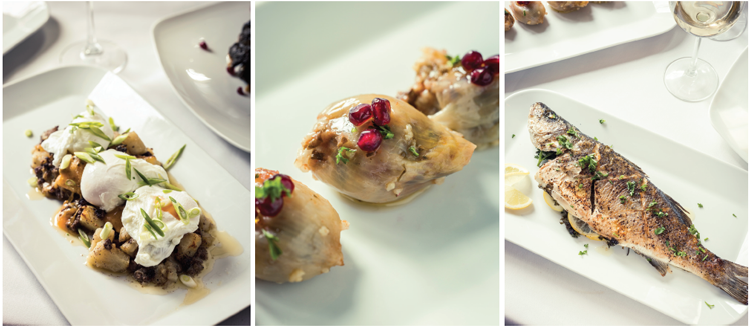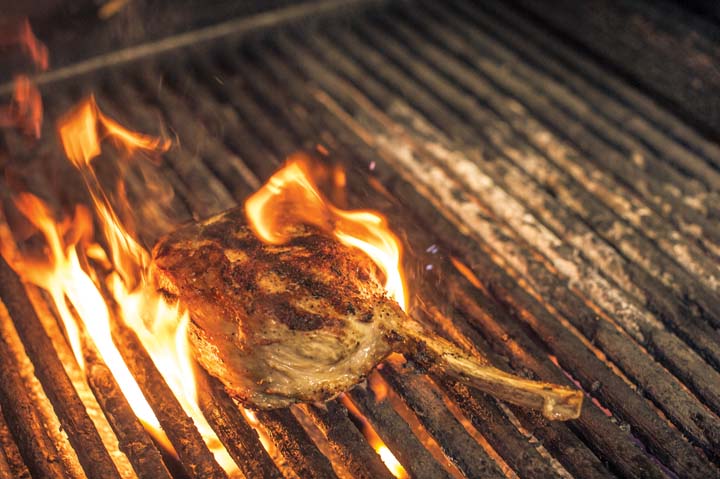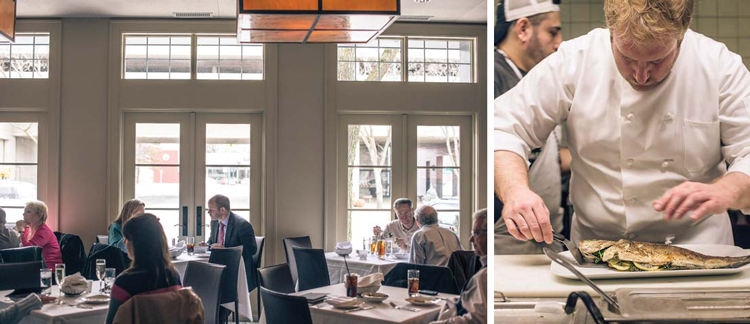
A restaurant, someone once said, has about the same average lifespan as a dog. (The dogs seem to live much longer.)
While restaurant longevity around Detroit hit its nadir during the recent recession, few have been around as long as Birmingham’s Phoenicia, the upscale Lebanese eatery that originally opened in Highland Park in 1971.
Phoenicia is one of the longest continuously running family restaurants in the area (in either dog or human years), and for more than four decades, it’s succeeded in setting the highest bar for Middle Eastern food in metro Detroit.
While longevity might merit distinction, it sometimes necessitates a face-lift. And that’s pretty much what Phoenicia owner Sameer Eid and his family have done.
And the newly nipped and tucked Phoenicia has never looked better. Architects Victor Saroki & Associates have taken the tony, polished, white-linen establishment and given it a crisp, warm, and inviting new interior and facade.
“One of the ideas behind it was to keep up with the times,” says Phoenicia manager Samy Eid. “My father (Sameer) and I [agreed] that to upgrade is to separate ourselves from the competition.”
And, oh yes, the food is as good as ever — from Middle Eastern specialties to Eid family-inspired spin-offs, such as single-serving-sized local whitefish cooked with Mediterranean spices and vegetable accents diced to mirepoix size.
Born in Lebanon and educated in America, Sameer Eid, 74, is one of the most recognizable figures on the metro Detroit restaurant scene. His manicured hands, his swooping white mustache, his regal bearing, and his immaculate tailoring are all reminiscent of a gentleman from a distant time and place — of the traditional French/Beiruti culture in which good manners and gentility were essential.
It persists in the ease and flow of this well-run restaurant. The courtesy that greets you when you walk through the door is extended throughout your entire visit. All of this makes Phoenicia a most gracious experience.

The remodeling has vastly changed Phoenicia, making it more contemporary. Saroki did away with some Moorish architectural touches — such as narrow, pointy windows — and opened it up to more natural light, giving it a calm and staid feel.
The decision to upgrade came only after Samy, 32, who was studying pre-law at the University of Michigan, decided to follow Sameer and make a career of Phoenicia, bringing a fresh eye to where the market was headed and how Phoenicia would fit into it.
“I always said I would never do this,” Samy says with a laugh. “I wanted to take a year off (after finishing college) and go live in the West,” which he did. “Then, my dad and I talked about it. … There is a need for what we do … I began to see this as something we can grow, but without risking the original idea of Phoenicia.”
“We decided to gut the place and start from scratch,” says Sameer.
The Saroki update is done in creamy limestone facing, framed in gray-green moldings and trim around the large windows, set off from the sidewalk by a half dozen waist-high planters filled with small Lebanon cedar bushes.The interior has a soft, pastel-like feel of quiet comfort and the low, efficient hum of service and a kitchen at work.
The new Phoenicia emphasizes high-quality dining and style first; and its Middle Eastern origins second. It’s a significant reversal of identity, and it works nicely.
At a glance, there’s not much unusual about Phoenicia’s menu.
The standard first course nibbles include a puréed chickpea hummus, a roasted eggplant baba ghanoush, and a yogurt-based labneh, all familiar items on Middle Eastern menus.
But Phoenicia also offers less common items, such as mouhamara made of roasted red peppers, walnuts, and pomegranate molasses, and makdouce — olive-oil-roasted eggplant with garlic and walnuts.
“We try to do things here that go against the norm of what you would expect in a Lebanese restaurant,” says Sameer.
Phoenicia’s first course consists of diminutive, yet delectable lamb sausages and pine nuts, scented with aromatic pomegranate molasses. Olive-oil-sautéed dandelions and onions; morel mushrooms served with basil, tomato, and garlic; and traditional standbys, like roasted red peppers and spinach pies, round out the course.
“We have kept the core of what my father always did,” Samy says.

There are also some new twists on old favorites. “Take the grape leaves,” says Sameer. “We use the same stuffing, but instead we are using Swiss chard. It’s not as chewy, and it has an extraordinary flavor.”
Occasionally, long-lost recipes from the Highland Park days re-emerge. A deboned trout, for example, stuffed with walnuts, parsley, cilantro, and spinach.
“I took it off the menu 17 years ago,” says Sameer. “One day a customer asked, ‘Do you remember that salmon you used to make?’ So I asked my supplier what he could get. He came up with pink trout, the right size. Now everybody wants it.”
In main plates, on a recent visit, the daily specials included fresh, succulent sweetbreads, a favorite of mine, which came lightly pan-sautéed and finished in a lemony sauce.
I’m also a big fan of kibbeh nayeh, made from the freshest, leanest lamb available, and blended with bulgur wheat and spices. It’s eaten raw, and Phoenicia’s version includes mint and fresh jalapeno, giving it a slightly different spin.
Baked kibbee is also on the menu, and it includes not only pine nuts but also almonds.
For vegetarians, Phoenicia is a bit of a paradise, offering a raft of meatless dishes, some small plates, some full plates: falafel; mjadara — green lentils with crispy onions; bulgur and tomatoes; and a squash stuffed with rice, vegetables, herbs, and tomato.
Main dishes include a wide assortment of fish, lamb, and beef, most prepared with Mediterranean touches: a little bit of Greece here, a dash of Spain there, and a touch of France in others.
For the less adventurous, there’s always the roasted, deboned chicken (garlic sauce on the side), a mixed grill, or a good old American bone-in rib-eye.

Phoenicia remains a family affair of the old school. Many mornings, Sameer is up early and headed down to Eastern Market, wandering the stalls and butcher shops in search of the freshest produce.
For four decades now, Sameer Eid has built and maintained fruitful relationships with his clientele. “Right now, we are serving three generations of customers here,” he says. “In Highland Park, I used to carry the babies of my customers around the restaurant (while their parents ate). Now those babies come here, and their babies are already young adults.”
And life marches on.
Phoenicia, 588 S. Old Woodward, Birmingham; 248-644-3122. L Mon.-Fri., D Daily.
Cook is Hour Detroit’s chief restaurant critic. Email: editorial@hour-media.com.
|
|
|









